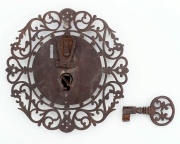Difference between revisions of "Wrought iron"
(username removed) |
(username removed) |
||
| Line 2: | Line 2: | ||
== Description == | == Description == | ||
| − | A malleable form of metallic [http://cameo.mfa.org/materials/fullrecord.asp?name=iron iron]. Wrought iron is nearly pure iron with less than 1 percent [http://cameo.mfa.org/materials/fullrecord.asp?name=carbon carbon] and about 2.5 percent [http://cameo.mfa.org/materials/fullrecord.asp?name=slag slag]. It was the only type of iron produced from iron ore until [http://cameo.mfa.org/materials/fullrecord.asp?name=cast | + | A malleable form of metallic [http://cameo.mfa.org/materials/fullrecord.asp?name=iron iron]. Wrought iron is nearly pure iron with less than 1 percent [http://cameo.mfa.org/materials/fullrecord.asp?name=carbon carbon] and about 2.5 percent [http://cameo.mfa.org/materials/fullrecord.asp?name=slag slag]. It was the only type of iron produced from iron ore until [http://cameo.mfa.org/materials/fullrecord.asp?name=cast%20iron cast iron] was developed in China in the 3rd century BCE. Wrought iron continued to be the only iron made in Europe and the Middle East until the medieval period. For production, the ore was smelted, then the resultant iron bloom was hammered, stretched, and annealed to remove impurities. It was then easily worked by forging, bending, rolling, and drawing. Modern wrought iron is industrially made from refined cast iron. Over the years, wrought iron has been used for many decorative items (hand-crafted church screens and body armor) as well as architectural components (hardware, roof sheeting, pipes, grilles, railings, and fences). |
== Synonyms and Related Terms == | == Synonyms and Related Terms == | ||
| − | weld iron; puddle steel; puddled iron, charcoal iron; fer | + | weld iron; puddle steel; puddled iron, charcoal iron; fer forgé (Fr.); Schmiedeeisen (Deut.); smeedijzer (Ned.); ferro forjado (Port.) |
== Additional Information == | == Additional Information == | ||
| − | Jonathan Taylor, Steve Suff, "Wrought Ironwork" Building Conservation Directory 2000: [http://www.buildingconservation.com/articles/wroughtIron/wrought2000.htm Link] | + | ° Jonathan Taylor, Steve Suff, "Wrought Ironwork" Building Conservation Directory 2000: [http://www.buildingconservation.com/articles/wroughtIron/wrought2000.htm Link] ° Wrought Iron Advisory Center: [http://www.realwroughtiron.com Link] |
== Authority == | == Authority == | ||
| − | * | + | * R. J. Gettens, G.L. Stout, ''Painting Materials, A Short Encyclopaedia'', Dover Publications, New York, 1966 |
| − | * | + | * G.S.Brady, ''Materials Handbook'', McGraw-Hill Book Co., New York, 1971 Comment: p. 882 |
| − | * | + | * David C. Scott, ''Metallography and Microstructure of Ancient and Historic Metals'', The Getty Conservation Institute, Los Angeles, 1991 |
* ''Dictionary of Building Preservation'', Ward Bucher, ed., John Wiley & Sons, Inc., New York City, 1996 | * ''Dictionary of Building Preservation'', Ward Bucher, ed., John Wiley & Sons, Inc., New York City, 1996 | ||
| − | * ''Encyclopedia Britannica'', http://www.britannica.com Comment: "wrought iron" | + | * ''Encyclopedia Britannica'', http://www.britannica.com Comment: "wrought iron" Encyclopædia Britannica [Accessed October 18, 2001]. |
* ''The Dictionary of Art'', Grove's Dictionaries Inc., New York, 1996 Comment: "Iron and Steel" | * ''The Dictionary of Art'', Grove's Dictionaries Inc., New York, 1996 Comment: "Iron and Steel" | ||
| − | * | + | * Website address 1 Comment: Link to Wrought Iron Advisory Center at www.realwroughtiron.com |
* Website address 2 Comment: Handbook on wrought Iron Conservation from Chriss Topp Co. at http://www.christopp.co.uk/pdfs/CToppStudentsConservation.pdf | * Website address 2 Comment: Handbook on wrought Iron Conservation from Chriss Topp Co. at http://www.christopp.co.uk/pdfs/CToppStudentsConservation.pdf | ||
| − | * | + | * External source or communication Comment: Submitted information from Steve Suff |
[[Category:Materials database]] | [[Category:Materials database]] | ||
Revision as of 07:39, 24 July 2013
Description
A malleable form of metallic iron. Wrought iron is nearly pure iron with less than 1 percent carbon and about 2.5 percent slag. It was the only type of iron produced from iron ore until cast iron was developed in China in the 3rd century BCE. Wrought iron continued to be the only iron made in Europe and the Middle East until the medieval period. For production, the ore was smelted, then the resultant iron bloom was hammered, stretched, and annealed to remove impurities. It was then easily worked by forging, bending, rolling, and drawing. Modern wrought iron is industrially made from refined cast iron. Over the years, wrought iron has been used for many decorative items (hand-crafted church screens and body armor) as well as architectural components (hardware, roof sheeting, pipes, grilles, railings, and fences).
Synonyms and Related Terms
weld iron; puddle steel; puddled iron, charcoal iron; fer forgé (Fr.); Schmiedeeisen (Deut.); smeedijzer (Ned.); ferro forjado (Port.)
Additional Information
° Jonathan Taylor, Steve Suff, "Wrought Ironwork" Building Conservation Directory 2000: Link ° Wrought Iron Advisory Center: Link
Authority
- R. J. Gettens, G.L. Stout, Painting Materials, A Short Encyclopaedia, Dover Publications, New York, 1966
- G.S.Brady, Materials Handbook, McGraw-Hill Book Co., New York, 1971 Comment: p. 882
- David C. Scott, Metallography and Microstructure of Ancient and Historic Metals, The Getty Conservation Institute, Los Angeles, 1991
- Dictionary of Building Preservation, Ward Bucher, ed., John Wiley & Sons, Inc., New York City, 1996
- Encyclopedia Britannica, http://www.britannica.com Comment: "wrought iron" Encyclopædia Britannica [Accessed October 18, 2001].
- The Dictionary of Art, Grove's Dictionaries Inc., New York, 1996 Comment: "Iron and Steel"
- Website address 1 Comment: Link to Wrought Iron Advisory Center at www.realwroughtiron.com
- Website address 2 Comment: Handbook on wrought Iron Conservation from Chriss Topp Co. at http://www.christopp.co.uk/pdfs/CToppStudentsConservation.pdf
- External source or communication Comment: Submitted information from Steve Suff
